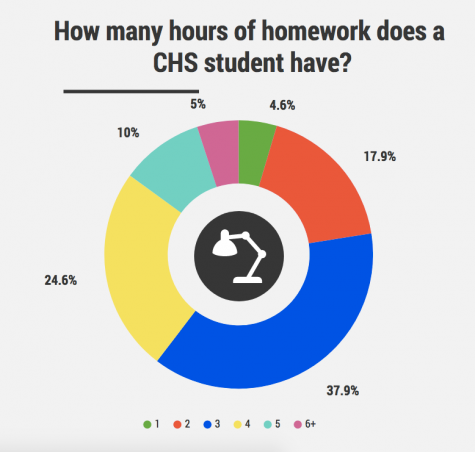Homework is an agonizing task for most high school students.
According to a September 2018 survey sent to all students at CHS, the 301 respondents self-reported that more than 60 percent of students take between three and four hours to complete their homework, with “more than four hours” being the second most popular option.

Is this really necessary?
Most studies on the correlation between homework and academic achievement are done on elementary school students, rather than middle and high school students — an interesting approach, considering the majority of homework stress comes from middle and high school.
Heidi Maier, the superintendent of the Marion County public schools and an expert on the acquisition of reading, tells the Washington Post that “[there is] research showing that traditional homework in the early years does not boost academic performance but reading — and reading aloud — does.”
The new homework policy for their elementary schools is to read for 20 minutes per night, giving the young students the freedom of selecting their own books. For young students, studies have shown that reading out loud for 20 minutes every night improves their language and brain development, which in turn exponentially boosts their standardized test scores.
This method is surprisingly uncommon in the U.S., but luckily, the Clayton School District caught onto this trend early. The results of spending just 20 minutes on one brain-exercising skill overpowered years of repetitive worksheets every night. Practice makes perfect, but this adage does not apply to our whole curriculum.
The homework itself isn’t the only issue, though.
Most students at CHS find time the biggest problem. In an anonymous survey, randomly selected students were asked to discuss their opinions on homework, in a casual, unstructured format.
Two out of every three responses included something along the lines of “I don’t understand why we have so much homework,” and “I don’t have time for hobbies anymore.”
Rather than a short recap, homework has slowly turned into the lesson’s replacement or an extension of it, so it makes sense why the assignments take so much time to complete.
Most students find it absurd that they have to spend seven hours of their weekdays at school, only to come home and spend their free time on more schoolwork — a large portion of the content not being covered during class.
In a public pre-K thought 5th-grade school in Vermont, principal Mark Trifilio banned all homework except reading for his students.
Instead, he told the elementary school students to go outside and play, and spend time with their family. The results were astounding.
No one in the class fell back academically. In fact, they became more creative thinkers in just six months.
Being able to explore their own passions and hobbies greatly improved their performance at school. The simple daily assignment of reading was all that was needed for the children to grow as students.
At CHS, most students have replaced their personal hobbies with finishing assignments and projects until ungodly hours of the morning, which must work wonders for their mental health. The workload has been commonly described as “insane” and “unmanageable”, not only by freshmen, but also juniors and seniors. Of course, reading for 20 minutes a night isn’t enough for an honors course at CHS, but the principle of fewer repetitive assignments would greatly improve the quality of life for high school students.

